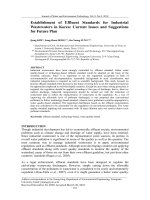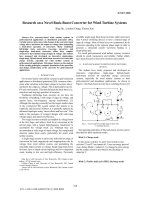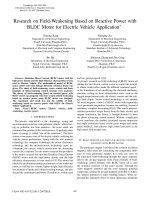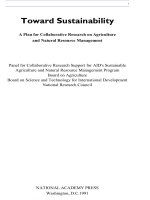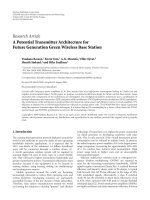Revisiting linguistic politeness theories: suggestions for future research on politeness phenomena
Bạn đang xem bản rút gọn của tài liệu. Xem và tải ngay bản đầy đủ của tài liệu tại đây (96.66 KB, 11 trang )
JOURNAL OF SCIENCE, Hue University, Vol. 70, No 1 (2012) pp. 181-191
REVISITING LINGUISTIC POLITENESS THEORIES: SUGGESTIONS FOR
FUTURE RESEARCH ON POLITENESS PHENOMENA
Pham Thi Hong Nhung, Pham Thi Tuyet Nhung
College of Foreign Languages, Hue University
Abstract. This article reviews the research literature on politeness, so as to make
suggestions for future research in the field of politeness and communication.
Among the extensive literature on politeness for the last three decades, Brown &
Levinson (1978, 1987)’s model of politeness has been considered the most
influential view of politeness but has also faced severe criticim from a newly
emerging body of politeness research. In the well-established literture on politeness,
politeness phenomenon is considered to be universal, and so it is possible to form a
common model of politeness for every culture and language (Terkourafi, 2005).
The current review presents a critical evaluation of relevant literature in order to
build the foundation on which suggestions for future research on politeness are
made.
1. Literature on linguistic politeness: A state of arts
It was not until the late 1970s that politeness became an important issue in
pragmatic studies (Kasper, 1990). When Grice first introduced his conversational
Maxims in 1975, he established one of the most important foundations on which leading
theories of politeness have been built (Brown & Levinson, 1978, 1987; Lakoff, 1973,
1975, 1990; Leech, 1983). These researchers, and those working in their framework,
tend to function toward a universal model of politeness. Although they do not
necessarily claim the universality of their model, they all propose a common model for
politeness, either implicitly in the form of Principles (e.g., Leech, 1983), Rules (Lakoff,
1973, 1990), or explicitly in a universal model (Brown & Levinson, 1978, 1987). What
all of these theories have in common is their emphasis on the linguistic presentation of
politeness (i.e., linguistic politeness).
1.1. Grice’S Conversational Maxims
Grice (1975) claims that people engage in conversation on the basis of the
Cooperative Principle (Fig. 1). He explains this principle as “make your conversational
contribution such as required, at the stage in which it occurs, by the accepted purpose or
direction of the talk-exchange in which you are engaged” (p. 45). This principle is then
represented in four related Maxims: Quantity, Quality, Relevance and Manner.
181
Revisiting linguistic politeness theories: suggestions for…
182
Cooperative Principle
Quantity
(no more & no less)
Quality
(truth-telling)
Manner
Relevance
(clearly-expressed)
(logic & relevant)
Fig. 1. Representation of Grice’s Maxims
Quantity means saying no more and no less than what is needed; Quality is
telling the truth; Relevance requires interlocutors to observe logical and precise
relevance to the matter at hand; and Manner means avoiding obscure expressions and
disorderly speech.
From the Gricean Maxims as a point of departure, Lakoff, Leech, and Brown &
Levinson all built their model of politeness on Grice’s Cooperative Principle (Watts,
2003). However, it is Lakoff (1973, 1975, 1990) who first introduced these Maxims into
the concept of politeness.
1.2. Lakoff’s Politeness Rules
Lakoff (1973, 1975, 1990) connected politeness with Grice’s (1975) Cooperative
Principle by introducing three main politeness rules, which are closely associated with
Grice’s four Maxims. These rules are: 1) don’t impose; 2) give options; and 3) make A
(i.e., the person you are communicating with) feel good, be friendly (i.e., creating a
comfortable and friendly feeling). The first two rules directly emphasize sensitivity
towards possible imposition in interactions (i.e., not imposing one’s ideas / thoughts on
one’s conversational partner), and the need to express this sensitivity by making choices
available for the partner. In other words, whenever possible in order to be polite people
involved in interactions should create a comfortable feeling for their interlocutor and let
him / her take decisions rather than they themselves. Lakoff then relates these three
main rules respectively to the relevant strategies (Figure 2.2): the Strategy of Distance
as impersonality (e.g., “Has the dog been fed?” instead of “You feed the dog”), the
Strategy of Deference as hesitancy (e.g., “I was wondering if […]”), and the Strategy of
Camaraderie as informality (e.g., “My name is Rose Smith, please call me Rose”).
Lakoff further argues that the emphasis and the realization of these rules, and hence of
their related strategies, vary across cultures. For example, Asian cultures tend towards
Deference / Hesitancy, while modern American culture would prefer Camaraderie /
Informality. Accordingly, the concept of “how to be polite” differs across cultures.
PHAM THI HONG NHUNG, PHAM THI TUYET NHUNG
Politeness Rules
183
Don’t impose
Strategy of Distance / Impersonality
Give options
Strategy of Deference / Hesitancy
Make A feel good
Strategy of Camaraderie / Informality
Fig. 2. Representation of Lakoff’s Politeness Rules and Strategies
Lakoff’s (1973, 1990) theory of politeness is based on the assumption that
interlocutors are equals. In other words, her theory puts aside the interlocutors’
interpersonal differences such as status and power. This missing component in Lakoff’s
model is then provided in Brown and Levinson’s (1978, 1987) concept of politeness
Weight (i.e., the amount and kind of a specific politeness strategy), and their formula of
how Weight is calculated.
1.3. Brown and Levinson’s Universal Model of Politeness: Saving face as
motivation for politeness
Brown and Levinson (1978, 1987) also define politeness as a tool to avoid
conflict and confrontation. They consider that “politeness, like formal diplomatic
protocol (for which it must surely be the model), presupposes that potential for
aggression as it seeks to disarm it, and makes possible communication between
potentially aggressive parties” (Brown & Levinson, 1987, p. 1). Drawn on Goffman’s
(1967) concept of Face, the model they propose is also centred on individual freedom
from imposition in action.
Brown and Levinson’s concept of Face (Figure 3) is sophisticatedly realized in
two aspects: positive face and negative face. Positive face refers to one’s want / desire to
be admired and approved of by other people; and negative face refers to one’s desire /
want to be free from any imposition:
I want you to want/need/respect/admire me
Positive Face
Face
I want you to love/admire what I want/love/admire
I want you to admire/love/approve of what I do
Negative Face
I want my full freedom in everything I do/say/think
I want you not to impose on me/mine
Do not tell me what I can/cannot/ should/should not
do/say/think
Fig. 3. Representation of Brown & Levinson’s concept of Face
Brown and Levinson (1978) affirm that “face is something that is emotionally
invested, and that can be lost, maintained, or enhanced, and must be constantly attended
to in interaction” (p. 61). The content of face may differ across cultures, but people’s
184
Revisiting linguistic politeness theories: suggestions for…
knowledge of their public self-image (i.e., face and the tendency to orient to face in
interaction) is universal. Borwn & Levinson maintain that any utterance can be facethreatening, and so any speech act can be a face threatening act (FTA). Any utterance
can negatively influence one’s and/or the other’s face (i.e., one’s and/or other’s want of
being approved, and of being fully free from imposition). For example, the utterance
“close the window now” violates one’s want of being free from imposition, because this
utterance is asking one to do something without one’s want, threatening one’s negative
face, and hence is not polite. Asking someone to do something without directly
threatening his / her face is when politeness comes into play. To be polite, one must use
different strategies such as indirectness (e.g., by using question like “Could you close
the window please?”), and giving hints (e.g., “It is so cold in here”), or combining the
two (e.g., “It is cold in here, isn’t it?”). Such strategies help interlocutors attend to each
other’s face. This argument makes the interlocutors’ sensitivity towards each other’s
desire to be free from imposition a key to the understanding of Brown and Levinson’s
notion of politeness.
Brown and Levinson also address the social factors that decide politeness weight
– the amount and kind of politeness in interaction – by introducing the Weightiness
formula: Wx = D (S, H) + P (H, S) + Rx. In this formula, x represents the selected
speech act, S the speaker, H the hearer, P the perceived power difference between the
hearer and the speaker, D the perceived social distance between them, and R the cultural
ranking of the speech act. As inferred from this formula, a selected politeness strategy is
based on the social distance between the speaker and the hearer (e.g., talking to a close
friend is different from conversing with a complete stranger), the power difference
between the two (e.g., talking to one’s boss is different from talking to one’s friend), and
the imposition level of the act involved (e.g., asking for a pay raise differs from
conveying good news). This formula is useful because it sheds light on interpersonal
and contextual variables – for instance, power and distance – which have an influence
on the politeness level of a strategy. The recognition of the impact of social factors on
the language use of politeness also suggests that, in spite of having access to linguistic
strategies, people must also consider some other factors before making decisions about
their language use.
Brown and Levinson place strong emphasis on the correlation between
imposition (negative face) and politeness. By reducing the possibilities in which
imposition may occur, and by reducing the degree of imposition of speech acts when
imposition does have to occur, people involved in linguistic interactions help save each
other’s face, and hence are polite. This view presents face, particularly the respect for
each other’s desire to be free from imposition, as the fundamental, and possibly the only,
motivating force for politeness (Spencer-Oatey, 2000), and it makes Brown and
Levinson’s theory “a theory of facework, rather than a theory of politeness” (Watts,
PHAM THI HONG NHUNG, PHAM THI TUYET NHUNG
185
2003, p. 97). Additionally, with the main focus on strategic politeness (i.e., politeness is
intentionally and consciously used as a strategy to gain / get something, for example, a
request), non-strategic politeness (e.g., phatic expressions used as social lubricant to
smooth social contacts, for example, greetings) is neglected in their model. It is in
Leech’s (1983) Politeness Principle that these gaps are partly filled, when impoliteness
is involved in the polite-impolite continuum, and both strategic and non-strategic
politeness are addressed.
1.4. Leech’s Politeness Principles
In Leech’s (1983) model, politeness is located within the framework of
“interpersonal rhetoric”, with the emphasis on the mutual influence between the
semantic sense and the pragmatic force of an utterance. For instance, “Can you pass the
salt?” is not so much taken as a question about someone’s ability (i.e., literal meaning),
but rather as a request for action (i.e., force), “pass the salt”. Leech adds the normative /
regulative aspects of politeness (i.e., non-strategic politeness) to the theory of politeness,
which he believes is not adequately discussed by Brown and Levinson. His recognition
of this type of politeness was later enriched by extensive research (e.g., Gu, 1990;
Matsumoto, 1988, 1989), and is often referred to in the ongoing discussion of different
distinctions of inferred politeness (e.g., one’s request in a question form is inferred to be
polite by the hearer) and anticipated politeness (e.g., greeting each other is expected by
two people who are acquaintances) (Haugh, 2003a).
Leech (1983) emphasized the polite-impolite continuum by incorporating both
notions in his definition of politeness. Seeing politeness as a means to minimise
impolite beliefs and maximise polite beliefs (respectively defined as beliefs that are
unfavourable and favourable to the hearer), he added the Tact, Generosity, Approbation
and Modesty Maxims to politeness theory. Central to these maxims are the concepts of
Cost, Benefit, Praise and Agreement. The Tact Maxim is defined as minimizing cost to
other and maximizing cost to self; the Generosity maxim as minimizing benefit to self
and maximizing benefit to other; the Approbation Maxim as minimizing disagreement
and maximizing agreement with other; and the Modesty Maxim involves minimizing
self-praise and maximizing other-praise.
Some of Leech’s terms are strikingly similar to those suggested by Brown and
Levinson (1978). For example, Leech’s notion of the hearer’s authority, which plays a
part in assessing the cost-benefit scale of the Tact and the Benefit Maxims, is very
similar to the assessment of power in Brown and Levinson (Watts, 2003). In Leech’s
view, the speaker’s perception of the hearer’s authority influences the speaker’s choice
of language use in terms of favourableness to the hearer. Similarly, in Brown and
Levinson’s (1978, 1987) Weightiness formula, the perceived power of the hearer also
plays an important role in the speaker’s choice of politeness strategies.
186
Revisiting linguistic politeness theories: suggestions for…
2. Well-Established Theories on Politeness: Its Workability and Vulnerability
2.1. Politeness in Anglo cultures: A Reinforcement of Brown & Levinson’s
model
The theories of politeness reviewed above, especially Brown and Levinson’s,
have established their place in the literature on politeness and have, to various extents,
been supported in much research on linguistic politeness in Anglo English-speaking
cultures. As the most developed theory of politeness, Brown and Levinson’s face-saving
view has been the most influential single framework in providing a paradigm for the
investigation of linguistic politeness (Kasper, 1990; Watts, 2003; Watts, Ide, & Ehlich,
1992). Its influence has been widely recognized: “it is impossible to talk about it
[politeness] without referring to Brown & Levinson’s theory” (Orecchioni, 1997, p. 11).
Their model of politeness has been supported by various studies on different politeness
speech acts, for instance, complimenting (e.g., Barnlund & Araki, 1985; Henderson,
1996; Herbert, 1989; Holmes, 1988; Nelson, Al-Batal, & Echols, 1996), requesting (e.g.,
Holtgraves & Yang, 1992; Shih, 1988; Yeung, 1997), apologizing (e.g., Berman &
Kasper, 1993; Suszczynska, 1999), expressing disagreement (e.g., Holtgraves, 1997),
and in many different domains such as health (e.g., Hummert & Mazloff, 2001;
Landrine & Klonoff, 1992; Spiers, 1998), organizational interactions (e.g., Harris, 2003;
Morand, 1996), business interactions (e.g., Yeng, 1997; Yli-Jokipii, 1994), educational
interactions (e.g., Rees-Miller, 2000), and language teaching (e.g., Weizman, 1989;
Wolfson, 1981). Furthermore, although Brown and Levinsons’s theory was originally
designed to analyse oral discourse, it has also been applied to research on written
discourse (e.g., Cherry, 1988; Hagge & Kostelnick, 1989; Graham & David, 1996).
2.2. East-Asian politeness studies: Questionining Western Theories in
Question
Several researchers on Asian politeness have shown that the Western emphasis
on strategic politeness reflects a paramount concern for individual rights (i.e., what is
owed to the individuals), whereas in many Asian Confucian cultures, politeness signals
a concern for duty (i.e., what is owed to the group) (e.g., Byon, 2006; Gu, 1990; Ide,
1989; Mao, 1994; Matsumoto, 1989). Typical of these researchers are Gu’s (1990)
research on Chinese politeness, and Ide (1989) on Japanese politeness, Haugh’s (2005)
examination of the concept of Face in Chinese culture and Pham’s (2007) on the
concept of Face in Vietnamese culture.
Gu’s (1990) suggestion for amendments to the existing politeness theories
comes from his critical comparison of the Western notions of Face and politeness and
their Chinese counterparts. He claims that politeness is more than just instrumental /
strategic. More importantly and first, it is normative (i.e., people do not just use
politeness as a tool to gain something, but rather they use it to conform to social norms).
PHAM THI HONG NHUNG, PHAM THI TUYET NHUNG
187
These norms in Chinese culture are formulated into two new Maxims: the SelfDenigration Maxim (i.e., denigrating the self and elevating the other), and the Address
maxim (i.e., one’s choice of a suitable term when addressing one’s communicative
partner), which, Gu believes, can better explain Chinese politeness. For example, in
terms of the Self-Denigrating Maxim, Gu argues that modesty is one of the
presentations of Self-Denigration, and that Chinese moral philosophy requires the
Chinese to appear modest. Alternatively, appearing modest is a Chinese social norm,
and Chinese politeness operates in accordance with this norm.
Gu’s claim that politeness phenomena are governed by social norms is supported
by much other research (e.g., Rong Chen, 1993; Gao, 1998a, 1998b; Pham, 2007; Smith
& Bond, 1994; Takaku, Weiner, & Ohbuchi, 2001; Triandis, 1989). For instance, Rong
Chen (1993) found that politeness strategies chosen by the Chinese when responding to
compliments, are governed by social norms rather than by individual wants. Specifically,
the Chinese subjects in his research have a significantly higher rate of compliment
rejection than their American counterparts. In the light of Brown and Levinson’s facesaving theory, rejecting compliments is face-threatening in the sense that this rejection
may threaten the compliment giver’s positive face (i.e., the desire to be approved of).
From another perspective, refusing a compliment may make the givers of the
compliment feel that their praise is not welcome. As a result, in order to avoid making
an FTA, the receiver should accept the compliment. By accepting the compliment the
receiver of the compliment is thereby polite. Nevertheless, the Chinese data in Chen’s
research show the opposite: the denial of compliments is polite. Chen then concluded
that the Chinese politeness data cannot be properly explained by Brown and Levinson’s
model.
While Gu illuminates the significant role of social rules which govern the
performance of politeness in Chinese as a major Asian culture, Ide (1989) places
emphasis on the distinction between strategic politeness – Volition (i.e., optional choice
of politeness strategies) – and the compulsory forms in politeness – Discernment in the
honorific-rich Japanese language.
In Ide’s (1989) culture-specific proposal (i.e., Japanese), politeness is viewed as
a means to maintain smooth communication. She introduced the concept of
Discernment (i.e., language usage according to social conventions rather than
interactional strategy) in Japanese politeness. This has been considered as one of the
most vigorous criticisms of Brown and Levinson’s universal model of politeness (Watts,
2003). Discernment operates in close association with linguistic forms, and the choice
of different linguistic varieties with different degrees of formality. A Japanese has to
follow socially obligatory verbal choices strictly in order to show relevant levels of
politeness. While a native speaker of English can both say “Today is Sunday” to anyone
without changing the form of the language use and be polite, in order to be polite when
188
Revisiting linguistic politeness theories: suggestions for…
saying something like “Today is Sunday” a Japanese has to make some changes to the
form of the words used (Obana, 2001, p. 727). Saying “the professor reads this” in
Japanese is theoretically either:
a) Sensei-wa kore-o [professor] yonda [read this]; or
b) Sensei-wa kore-o [professor] oyomi-ni-natte [read this] (Ide, 1989, p. 227) .
In the latter the honorific form of oyomi-ninatte instead of yonda in the former is
used to refer to the action of a person of higher status, a professor. Ide argues that this is
because Japanese social rules require the speaker to be polite to a higher status person
(e.g., a professor). Therefore, “the concord of honorifics is socio-pragmatically
obligatory” (Ide, 1989, p. 227), and so b) is appropriate, but a) is not. In the Japanese
culture it is not true that individuals can always decide to be polite or not (i.e., Volition,
to be free to choose politeness strategies), but rather they also have to employ socially
obligatory linguistic forms in undertaking politeness acts.
Additionally, Ide argued that like Brown & Levinson’s model, with its stress on
linguistic strategies as the principal feature of Anglo politeness theories, none of the
existing frameworks of politeness appears adequate for explaining honorific languages.
Ide’s argument is supported by many other researchers (e.g., Matsumoto, 1989; Yu,
2002; Haugh, 2006; Pham, 2007). For instance, in referring to the importance of “social
identity” in the Japanese concept of Face, Matsumoto (1988) illustrates the discrepancy
between the Japanese notion of Face and that of Brown and Levinson, and argues that
the latter makes erroneous predictions for Japanese politeness. In order to be polite, a
Japanese person must understand his/her position in relation to other(s), and must
verbally acknowledge his/her dependence on others. “Acknowledgement and
maintenance of the relative position of others, rather than preservation of an individual’s
proper territory, governs all social interaction” (Matsumoto, 1988, p. 405). Chinese face,
Vietnamese face and Japanese face gravitate toward hierarchical interdependence and
social recognition, and are oriented toward an ideal social identity and even the concept
of face in these Confucian cultures may also just be different from that of Brown and
Levinson’s model.
3. Suggestions for Future Research on Politeness
3.1. A Call for Culture-Specific Research
Our critique has shown that the well-established theories of politeness are
complementary frameworks of the linguistic presentation of politeness. Being centred
in the individual’s will (i.e., the desire to have full freedom in making decisions and to
be free from imposition in action) and on the linguistic presentation of politeness (i.e.,
what to say / politeness strategy), politeness has been viewed by Western theories, from
an instrumental view rather than from the perspective where it is described as a
PHAM THI HONG NHUNG, PHAM THI TUYET NHUNG
189
normative behaviour, as in major Asian cultures. Apart from face-saving, there are other
culture-conditioning factors that function as motivations for politeness phenomena.
Accordingly, politeness is more than Face (Eelen, 2001; Watts, 2003, Spencer-Oatey,
2002, 2003, 2005), at least in major Asian Confucian cultures. What most of the major
research on politeness in cultures such as Chinese, Japanese, Korean and Vietnamese
has noticed, but has not adequately addressed, is the influence of Confucianism on
politeness phenomena in these cultures.
The criticism of the “universal” model of Brown and Levinson has been running
for almost three decades now, and more than one alternative model of politeness has
been proposed. However, we are still far from a model which works satisfactorily for
both Anglo and Asian Confucian politeness, and which properly addresses different
aspects of politeness. Janney and Arndt (1993) claim that Brown and Levinson’s theory
of politeness lacks a culturally unbiased conceptual framework for an objective and
empirical evaluation of their model. On the one hand, the recognition of the culturespecific nature of politeness offers insights into the significant impact of culture on
politeness phenomena. It also challenges the claim of universality of the existing theory
of politeness by showing that the present model and related frameworks are not properly
applicable to politeness, at least in major Asian Confucian cultures, suggesting that
major amendments are needed to the existing theories of politeness. This can be done by
more reseach on politeness phenomenon from cultures and language other than English
and Anglo culture. Examination of politeness behaviour in intercultural contexts where
people of different cultures communicate, using the same language can also offer
opportunities to explore how cultural values could influence this phenomenon.
3.2. A Call for a Context-Specific Approach
Among the recent substantial critiques, as well as major proposals of the
traditional theories of politeness, is the view that politeness is context-specific, and
hence cannot be universal. These new lines of investigation relate specifically to a more
post-modern and discursive framework (see Spencer-Oatey, 2002). For instance,
“rapport management is at the heart of politeness practices” (Terkourafi, 2005, p. 241),
and politeness is closely associated with rapport management (Bargiela-Chiappini &
Harris, 2006). Typical representatives of this approach are Eelen (2001), Watts (2003),
and their advocates (e.g.,Thornborrow, 2002). This emerging body of literature presents
potential opportunities again for intercultural investigations of politeness and involves a
shift of methodology and orientation in the direction of Critical Theory. This would take
our investigation outside its stated empirical goals, based on the investigation of
politeness and its cultural and context-conditioned motivations.
The existing critiques raise more questions about politeness and politeness
phenomena than they answer. For instance, Eelen calls for an enquiry beyond the
Revisiting linguistic politeness theories: suggestions for…
190
surface of the existing theories of politeness and a deeper understanding of the social /
cultural assumptions underlying these assumptions, but in his critique it is not clear
what these underlying assumptions might be. Additionally, in both Eelen (2001) and
Watts (2003), possible sources of the differences between Asian, specifically Asian
Confucian, politeness theories and Anglo politeness theories, are rarely addressed. As
Terkourafi (2005) maintains, this recent context-specific approach of politeness has not
been empirically tested. Hence, further investigations on the conditionining of context
and the culture-conditioned motivations of politeness phenomena in relation to its
linguistics presentation are needed to enable substantial amendments to the existing
literature.
References
[1]. Bargiella-Chiappini F., Harris S., Politeness at work: Issues and challenges, Journal of
Politeness Research, 2, (2006), 7-33.
[2]. Brown P., Levinson S., Universals in language usage: Politeness phenomena. In E. N.
Goody (Ed.), Questions and politeness. Cambridge: Cambridge University Press,
(1978), 57-324
[3]. Chen G. M., Self-disclosure and Asian students' ability to cope with social difficulties in
the United States, Journal of Psychology, 127(6), (1993), 603-610.
[4]. Eelen G., A critique of politeness theories, Manchester: St. Jerome Publishing, 2001.
[5]. Grice H. P., Logic and conversation, In P. Cole & J. Morgan (Eds.), Syntax and
semantics, New York: Academic Press, Vol. 3. Speech acts, (1975), 107-142.
[6]. Gu Y., Politeness and Chinese face, Lecture given in the Department of. Linguistics,
University of Luton, Summer 1998.
[7]. Haugh M., The discursive challenge to politeness research: An interactional
alternative, Journal of Politeness Research 3(2), (2007), 295-317.
[8]. Ide S., Formal forms and discernment: Two neglected aspects of universals of
linguistic politeness, Multilingua, 8(2-3), (1989), 223-257.
[9]. Lakoff R., The logic of politeness, or minding you p's and q's, Chicago Linguistic
Society, 9, (1973), 292-305.
[10]. Leech G., Principles of pragmatics, New York: Longman, 1983.
[11]. Matsumoto Y., Politeness and conversational universals – Observations from
Japanese, Multilingua, 8(2), (1989), 207-221.
[12]. Pham Thi Hong Nhung, Vietnamese concept of face: evidence from its collocational
abilities. E-Journal of Foreign Language Teaching 4(2), (2007), 257-266.
PHAM THI HONG NHUNG, PHAM THI TUYET NHUNG
191
[13]. Spencer-Oatey H., Managing rapport in talk: Using rapport sensitive incidents to
explore the motivational concerns underlying the management of relations, Journal of
Pragmatics, 34, (2007), 529-545.
[14]. Terkourafi M., Beyond the micro-level in politeness research, Journal of Politeness
Research, 1, (2005), 237-262.
[15]. Thornborrow J., Power talk: Language and interaction in institutional discourse,
Harlow: Longman, 2002.
[16]. Triandis H. C., Cross-cultural psychology, Asian Journal of Social Psychology, 2(1),
(1999), 127-143.
[17]. Vu Thi Thanh Huong, Khái niệm thể diện và ý nghĩa đối với việc nghiên cứu ứng xử
ngôn ngữ, Ngôn Ngữ 1, (2002), 8-14.
[18]. Watts R. J., Politeness, Cambridge: Cambridge University Press, 2003.
[19]. Yu M., On the universality of face: Evidence from Chinese compliment behavior,
Journal of Pragmatics, 35, (2003), 1679-1710.
